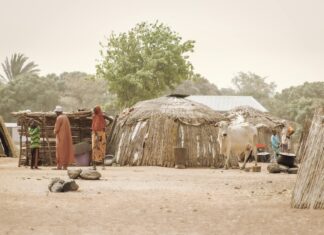Introduction
The discourse about and around the person or retired General Ibrahim Badamasi Babangida and his roles in Nigeria’s contemporary history had been as rich as it has been controversial. Scholars, journalists and freelance analysts alike had debated and commented on his leadership style, legacies, achievements and perceived pitfalls while he held the reigns of the nation Nigeria. This article views the former Nigeria’s Military President from historical perspective and points out certain historical facts about his involvement in Nigeria’s nation building that cannot be taken away from him. This becomes necessary because of the seriously perplexed state Nigeria is presently which has defied all known solutions. Ibrahim Babangida belonged among a few surviving Nigerian leaders that did not only witness the creation of modern Nigeria but did participate very actively in same.
Ibrahim Babangida before his Military Presidency
Babangida was among the first set of Nigerians that were trained and commissioned as military officers shortly after independence. He later went on to participate actively in the Nigerian Civil War (a thirty month fratricidal shooting war fought to prevent Nigeria from going to pieces) 1967-1970. History of Nigeria military governance did also show that he was part and parcel of virtually all the military rules before his own in 1985. He served in different capacities in the previous military regimes up until the Buhari-Idiagbon Regime directly preceding his own wherein he was a service chief and a member of the Supreme Military Council.
Not very many of his peers and contemporaries had the privilege of being part of successive Nigerian governments over such a long period of time. His peculiar experiences across many regimes in Nigeria did afford him the opportunity to understand the nature of and issues with the Nigerian project. His roles and achievements under the previous regimes were not immediately visible since he was under instructions and only occupied service postings that were subject to constant redeployment without prior notices. It was not until he took over power in a palace coup against his superior (General Muhammadu Buhari) in August 1985 that he became a household name in Nigeria. This article highlighted a few points worthy of note about how Babangida went about addressing the malaise afflicting Nigeria from his own perspective.
Ibrahim Babangida as Nigeria’s Military President
The psychological trauma and mental agony to which the Buhari-Idiagbon government subjected Nigerians predisposed the populace to welcome Babangida with both hands when he seized power in 1985. It must be acknowledged that Babangida was a very intelligent and experienced officer. With his wealth of experiences, he took deliberate steps at deodorizing the brutalities associated with the regime he just overthrew and created the ambience of an inclusive government. He mentioned, in his inaugural address to Nigerians, that he would give sufficient room for free press and fundamental human right.
How much or less this was realized is a different topic altogether. However, that he mentioned it at all almost made him a darling of the people since such was not obtainable in the previous regime. He went further, along that line, to drop the title “Head of State” for “President”. The former was associated with military highhandedness while the latter sounded more democratic and egalitarian. Babangida was addressed as “President” until he stepped aside in 1993.
Apart from Buhari’s regime that was considered repressive, one other reason for which Babangida overthrew his boss was his apparent non-interest in allowing for transition back to civil rule. Cashing in on the above, Babangida announced his preparedness to arrange a transition to civil rule. The political bureau was established and consultations were made widely for useful ideas and suggestions towards truly creating a new political order upon which a sustainable democratic government could be established. So long as Nigerians were promised the installation of a democratically elected government at the end of the transition programme, it was acceptable to the people. The President went ahead to set a number of qualifications and criteria which potential aspirants to various political offices in the land must meet before accreditation to participate. While the political transition programmes were going on, Babangida executed many policies to reform the economy as well as physical projects and infrastructures which shall be discussed hereunder.
The Structural Adjustment Programme
The Structural Adjustment Programme (SAP) was President Babangida’s response to the myriads of economic malaise afflicting Nigeria in the early 1980s. the policy was actually a baby of the International Monetary Fund (I.M.F) for the Third World Countries and Babangida only accepted and executed it in Nigeria. That reform was arguably the first policy of his administration that triggered off widespread protest across Nigeria. This was because of the direct uncomfortable impacts it had on the livelihoods of most Nigerians. He still went ahead to implement the policy despite the protests. Organised labour, the loudest of which was ASUU, protested all they could but could not dissuade the regime from proceeding with SAP, as the policy was called for short. While the policy might not, in itself, be anti-people or inimical to economic prgress, the regime implementing it did not have or make sufficient contingency plans such as could lessen the hardship it inflicted on the citizenry.
State Creation
Other than SAP, another area the impact of Babangida’s administration was most long-lasting was in the creation of states. He alone created eleven out of the 36 states presently in Nigeria. In 1987, he created Aqua Ibom State and Katsina State respectively. This he followed up in 1991 by creating Abia, Enugu, Delta, Jigawa, Kebbi, Osun, Kogi, Taraba and Yobe States.[1] These states were created primarily in response the complaints of both perceived and real cases of marginalisation of the ethnic minority groups by the majority groups in Nigeria. When he assumed office in 1985, there were nineteen states in Nigeria and by the time he left in 1993, it had grown to thirty states, curtesy of Ibrahim Babangida.
This article found, however, that in spite of the intention of state creation to eliminate the alleged marginalisation complaints, it has only grown louder with each passing day. More and more people are clamouring for state creation while the more extreme ones, in recent times, are even mobilising a mass to secede from Nigeria. This served to demonstrate that the issue of mutual disagreement over the acceptable federating formula in Nigeria is much more than creating more states could successfully cure. If state creation was the magic wand, increment from only three regions, at independence, to thirty-six states presently would have doused the tensions of “marginalisation” among the ethnic nationalities comprising Nigeria. The Nigerian experience had showed that mere state creation or even breaking away from Nigeria would not lead to sustainable nationhood.
Physical Projects
President Babangida did complete many physical projects across Nigeria which positively affected the lives of the citizens. One of such was the construction of the Third Mainland Bridge connecting Lagos Island with the Mainland. Upon completion, the bridge reduced the hardship that commuters daily encountered to and from work inside traffic gridlocks. Another one was the completion of the Federal Capital Territory in Abuja and relocation thereto before he left office. While the project was not initiated by him, its completion surely had positive demographic impacts on Nigeria. It freed up spaces in Lagos for use by the Lagos State Government and its people.
Transition to Civil Rule
Of all the achievements of Babangida’s administration, the one for which he was mostly remembered, with not-so-much nostalgia, was the transition to civil rule. It culminated in the annulment of June 12 1993 Presidential Election results believed to have been won by the Social Democratic Party Presidential Candidate, Late Chief M.K.O. Abiola. The transition itself appeared like it would last forever. Nigerians were kept in suspense as the transition timeline continued to get shifted forward by Babangida. Political parties were formed by Nigerian politicians and were later banned and barred from participating in elections.
At the long last, two political parties were created, namely: the Social Democratic Party (S.D.P) and the National Republican Convention (N.R.C) it was on the platform of the above two parties that the presidential election was conducted in 1993. The two presidential candidates were chief M.K.O Abiola for S.D.P, and Alhaji Bashir Tofa for N.R.C respectively. The elections were witnessed both locally and from outside and were adjudged to be freely and fairly contested. However, certain circumstances, which were yet to be made very clear to Nigerians, led President Ibrahim Babangida to unilaterally cancel and bar the National Electoral Commission Chairman, Prof Humphrey Nwosu from continuing with the announcement of the election results. This singular act threw Nigeria into the outer darkness and it was in the heat generated by the June 12 Crises that President Babangida stepped aside (using his own words) from the leadership of Nigeria and installed Chief Ernest Shonekan to head an Interim National Government. The above, in a nut shell was how Nigeria fared during President Babangida’s tour of duty as the Head of state and Commander-in-Chief of the Armed Forces of Nigeria.
Conclusion
This short article had attempted a panoramic historical view of the roles President Babangida played in Nigeria’s nation-building efforts. The article showed him as a veteran in Nigerian political experiences and pointed out some of the concrete contribution he made towards the evolution of modern Nigeria. It showed that he was initially widely accepted by the Nigerian people especially because of their traumatized experiences during the immediately preceding regime. The support, however, began to wane as he started to execute policies which most of the citizens perceived not to be in their interests. The article found that the last straw that broke the camel’s back in Babangida’s administration was the manner in which he handled the transition to civil rule programme; which did not lead to any civil rule after eight long years. It concluded that President Babangida should be viewed from a balanced perspectives rather than allow the perceived blunders he made while in office to becloud the view of his visible achievements in the making of modern Nigeria.
R.F. Obinta, PhD
Department of History,
Obafemi Awolowo University, Ile-Ife, Nigeria.
rfobinta@oauife.edu.ng.
[1] E.N. Ota, (et al), Creation of States in Nigeria, 1967-1996: Deconstructing the History and Politics”, in American Research Journal of Humanities and Social Sciences. Vol. 6, Issue 1, p.3.










